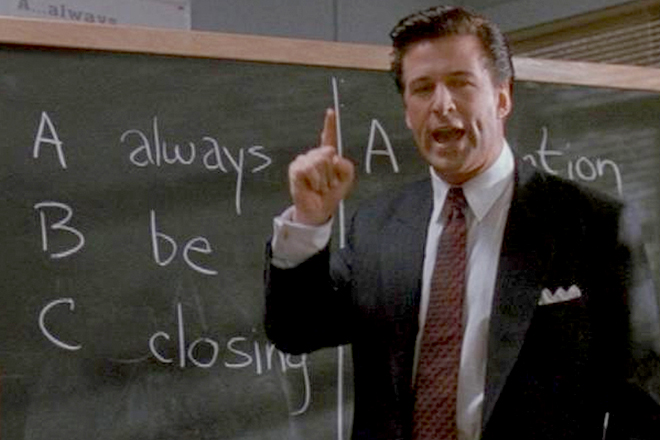Over the past year I have been hearing more and more criticism of Salesforce.com and other Salesforce Automation applications. Experts are challenging the value proposition of today’s SFA – questioning whether it really helps sales reps to sell more. Or whether SFA is really designed to help management track rep activity, sales pipeline and deal status.
If we were going to design an application that would help sales reps to sell, what would it do and how would it behave? I think this new application would be more like a virtual assistant than an ERP application, talking more like Siri than Larry Ellison.
Let’s call the virtual assistant Blake (named after Alec Baldwin’s character in Glengarry Glen Ross ). Blake is designed to help you sell more. His mission is to ensure that you don’t end up in second place with a set of steak knives.
Every morning Blake scans various data sources and social networks to develop a recommended “To Do” list for your morning. This morning Blake discovered on LinkedIn that a first degree connection CIO switched to a new job. Blake recommends giving him/her a call to discuss how you might be able to help with new role. He even has a draft email prepared for you to review and send. Blake also identified via a PRNewswire feed that an account in your territory just purchased SAP. He recommends giving the contact a call to discuss how your services can help generate more ROI from their ERP installation.
Blake saves each sales rep thousands of hours of pre-call research time every year – including the type of time-consuming research that most reps don’t or won’t do. But his biggest value is helping real time with customer calls. He listens in on all of your calls, transcribing the conversation so every word is captured. Blake allows you to focus on listening to the customer rather than trying to multi-task by taking notes or looking up data. As the customer is talking, Blake recommends talking points or questions to ask based upon his pre-call research.
For example, Blake can help with icebreakers. Checking social media, Blake identifies that the CIO you are calling is a huge sports fan and a University of Texas graduate. Blake recommends asking him for his prediction on the upcoming Tex-OU game the following Saturday. On another call, he finds a recent SlideShare presentation that the CFO you are speaking delivered at a conference last week. Blake suggests referencing slides number 6, 9 and 12 along with some insightful commentary.
After the icebreakers, Blake displays on the screen the most important known information about the customer. He identifies any existing relationship including products/services used; estimated annual spend and prior purchasing dates. Blake notes any customer service concerns expressed externally on social media or captured by agents on the company CRM application. He identifies the three most closely related customers along with two to three sentences of content to reference about each account to help build credibility. Now you are prepared to start the meat of the call by providing an update on the account and changes since you last spoke.
Ten minutes later your prospect mentions an unfamiliar term. Blake “Googles” the term and provides a summary definition along with links to click for additional information. Now you can more forward intelligently instead of chewing up time asking the prospect to explain the new term.
Your customer asks a tough question that you have never heard before. Blake queries the database of all prior phone calls he has transcribed. He identifies instances of when the question has been asked before and how the other sales reps responded. Now you can confidently respond on the phone rather than using the weaker “let me get back to you on that” response.
With five minutes remaining on the call, Blake recommends two to three closing strategies with the next best action for follow up. He recommends what content to send next. He recommends whether to suggest a demo or an expert consultation. He automatically drafts an email to send and puts a reminder notification in your calendar. And Blake makes all the appropriate updates to the SFA application recording the time of the call; meeting attendees; and list of action items.
It’s now 10:15am and time for you to go grab a cup of coffee. But Blake keeps working in your absence. He works through the to-do list making additional calls. Unreachable contacts are left one of several pre-recorded voice mails personalized with your voice signature.
At 10:20am Blake successfully connects with a prospect and does the call for you. His listening and speaking abilities are so good that the human on the other end of the call doesn’t know he is talking to a computer. And a new era of robo-calling is born.










